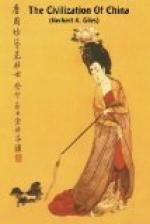When the armies of these states went into battle they formed a line, with the bowmen on the left and the spearmen on the right flank. The centre was occupied by chariots, each drawn by either three or four horses harnessed abreast. Swords, daggers, shields, iron-headed clubs some five to six feet in length and weighing from twelve to fifteen pounds, huge iron hooks, drums, cymbals, gongs, horns, banners and streamers innumerable, were also among the equipment of war. Beacon-fires of wolves’ dung were lighted to announce the approach of an enemy and summon the inhabitants to arms. Quarter was rarely if ever given, and it was customary to cut the ears from the bodies of the slain. Parleys were conducted and terms of peace arranged under the shelter of a banner of truce, upon which two words were inscribed—“Stop fighting.”
The beacon-fires above mentioned, very useful for summoning the feudal barons to the rescue in case of need, cost one sovereign his throne. He had a beautiful concubine, for the sake of whose company he neglected the affairs of government. The lady was of a melancholy turn, never being seen to smile. She said she loved the sound of rent silk, and to gratify her whim many fine pieces of silk were torn to shreds. The king offered a thousand ounces of gold to any one who would make her laugh; whereupon his chief minister suggested that the beacon-fires should be lighted to summon the feudal nobles with their armies, as though the royal house were in danger. The trick succeeded; for in the hurry-skurry that ensued the impassive girl positively laughed outright. Later on, when a real attack was made upon the capital by barbarian hordes, and the beacon-fires were again lighted, this time in stern reality, there was no response from the insulted nobles. The king was killed, and his concubine strangled herself.




